The Impact of Inequality on Economic Growth: A Comprehensive Analysis
VerifiedAdded on 2023/06/12
|7
|1114
|360
Essay
AI Summary
This essay examines the intricate relationship between economic inequality and economic growth, highlighting that economic growth often leads to increased inequality. It identifies inequality in wealth, income, and consumption, using indicators like the Gini coefficient and poverty rates. While economic growth is measured by GDP, the essay acknowledges GDP's limitations, especially in the digital economy. Factors driving economic growth, such as physical capital, labor efficiency, and technology, are discussed. The essay also addresses the global rise in income inequality, attributing it to globalization, technological advancements, and institutional problems. It concludes that while the global economy is growing, the benefits are not equally distributed, necessitating policies to combat inequality and poverty. The document references various sources to support its analysis of economic trends and disparities.
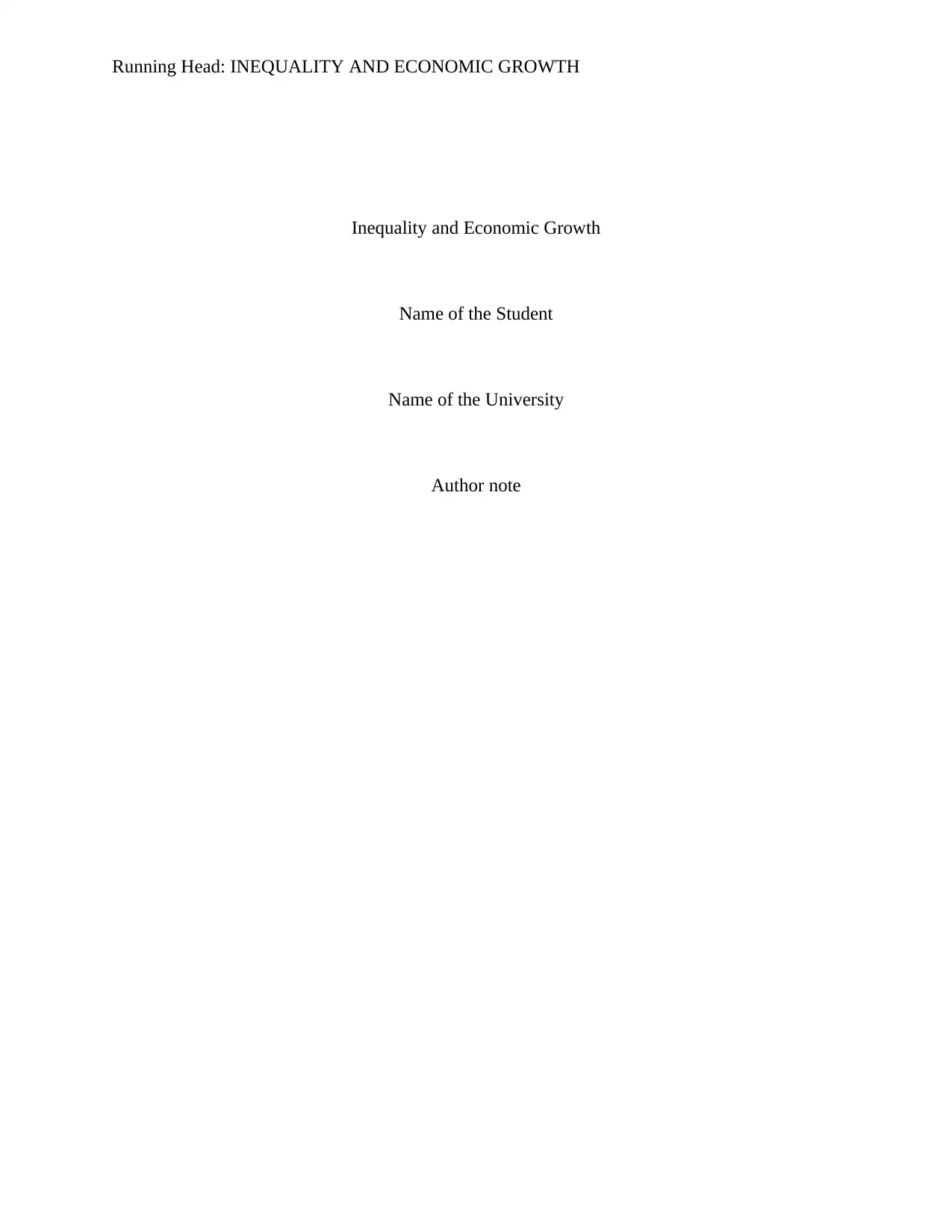
Running Head: INEQUALITY AND ECONOMIC GROWTH
Inequality and Economic Growth
Name of the Student
Name of the University
Author note
Inequality and Economic Growth
Name of the Student
Name of the University
Author note
Paraphrase This Document
Need a fresh take? Get an instant paraphrase of this document with our AI Paraphraser
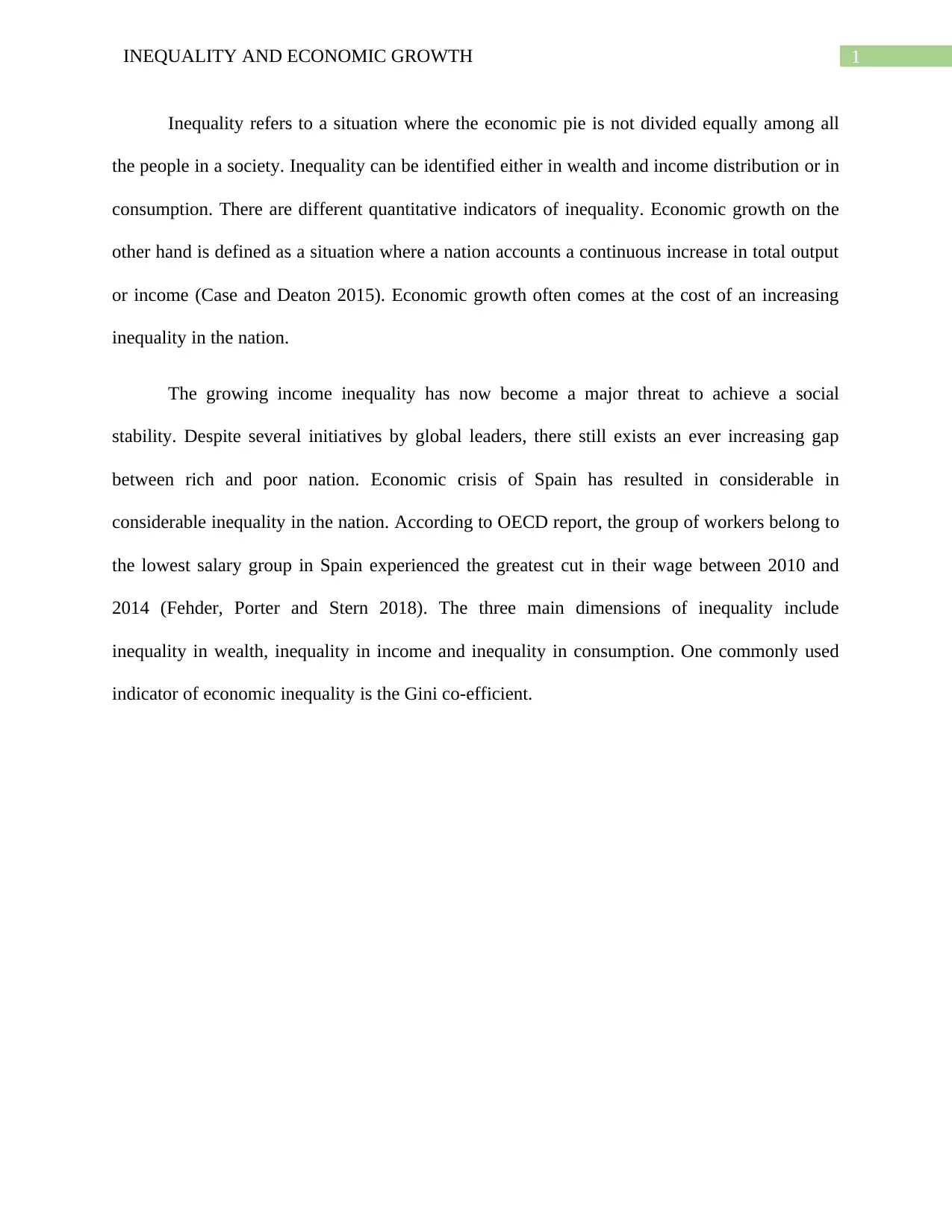
1INEQUALITY AND ECONOMIC GROWTH
Inequality refers to a situation where the economic pie is not divided equally among all
the people in a society. Inequality can be identified either in wealth and income distribution or in
consumption. There are different quantitative indicators of inequality. Economic growth on the
other hand is defined as a situation where a nation accounts a continuous increase in total output
or income (Case and Deaton 2015). Economic growth often comes at the cost of an increasing
inequality in the nation.
The growing income inequality has now become a major threat to achieve a social
stability. Despite several initiatives by global leaders, there still exists an ever increasing gap
between rich and poor nation. Economic crisis of Spain has resulted in considerable in
considerable inequality in the nation. According to OECD report, the group of workers belong to
the lowest salary group in Spain experienced the greatest cut in their wage between 2010 and
2014 (Fehder, Porter and Stern 2018). The three main dimensions of inequality include
inequality in wealth, inequality in income and inequality in consumption. One commonly used
indicator of economic inequality is the Gini co-efficient.
Inequality refers to a situation where the economic pie is not divided equally among all
the people in a society. Inequality can be identified either in wealth and income distribution or in
consumption. There are different quantitative indicators of inequality. Economic growth on the
other hand is defined as a situation where a nation accounts a continuous increase in total output
or income (Case and Deaton 2015). Economic growth often comes at the cost of an increasing
inequality in the nation.
The growing income inequality has now become a major threat to achieve a social
stability. Despite several initiatives by global leaders, there still exists an ever increasing gap
between rich and poor nation. Economic crisis of Spain has resulted in considerable in
considerable inequality in the nation. According to OECD report, the group of workers belong to
the lowest salary group in Spain experienced the greatest cut in their wage between 2010 and
2014 (Fehder, Porter and Stern 2018). The three main dimensions of inequality include
inequality in wealth, inequality in income and inequality in consumption. One commonly used
indicator of economic inequality is the Gini co-efficient.

2INEQUALITY AND ECONOMIC GROWTH
Figure 1: Economic inequality in Spain
(Source: Chartbookofeconomicinequality.com 2018)
Another indicator of income inequality is the share of population living below the
poverty line. Absolute poverty is a situation where people earn less than $1.25 per day (Oishi
and Kesebir 2015). The computation of absolute poverty include adjustment for an overtime
change in price and corresponding differences in price.
Economic growth of a nation is measured in terms of a persistent rise in Gross Domestic
Product. The Gross Domestic Product is a representative measure of total production, total
expenditure and total income of a nation. In order to compare GDP of different nations a CPI
adjusted measure known as purchasing power parity is used. Per capita GDP is a measure
obtained by dividing total GDP by total population (Mankiw 2014). In an emerging digital
economy, the use of GDP is flawed measure as these goods in most case have almost zero
marginal cost and hence, have a zero equilibrium price. Gross National Product also does not
Figure 1: Economic inequality in Spain
(Source: Chartbookofeconomicinequality.com 2018)
Another indicator of income inequality is the share of population living below the
poverty line. Absolute poverty is a situation where people earn less than $1.25 per day (Oishi
and Kesebir 2015). The computation of absolute poverty include adjustment for an overtime
change in price and corresponding differences in price.
Economic growth of a nation is measured in terms of a persistent rise in Gross Domestic
Product. The Gross Domestic Product is a representative measure of total production, total
expenditure and total income of a nation. In order to compare GDP of different nations a CPI
adjusted measure known as purchasing power parity is used. Per capita GDP is a measure
obtained by dividing total GDP by total population (Mankiw 2014). In an emerging digital
economy, the use of GDP is flawed measure as these goods in most case have almost zero
marginal cost and hence, have a zero equilibrium price. Gross National Product also does not
⊘ This is a preview!⊘
Do you want full access?
Subscribe today to unlock all pages.

Trusted by 1+ million students worldwide

3INEQUALITY AND ECONOMIC GROWTH
include quality of health, education, poverty and other qualitative index. Despite this
shortcomings, GDP is often used as a measure of economic well-being. The advantages of using
GDP are it is an objective indicator that is based on economic theory and helps to design suitable
economic policy. Countries can be compared based on their respective GDP. GDP is related with
some of the indicators of well-being. Most importantly, GDP represents the significance of
economic growth.
Two types of economic growth are catch up growth and sustained growth. Catch up
growth is the process by which developing countries using the growth engine catch up with
developed nations. The outstanding growth performance of Chile, Hong Kong and South Korea
constitute instances of catch up growth. The advanced countries such as UK, US, France and
others have sustained their growth for a long period of time (Case and Deaton 2015). Different
factors contributing to economic growth include increasing stock of physical capital, increasing
efficiency of labor and employment of advanced technology.
World economy is growing at a fast pace. World GDP in the last few decades have grown
rapidly and is expected to grow in future. Between 1820 and 1992 inequality within the countries
though had decline but inequality between countries and total inequality had increased. The
income shares of top 1% has increased overtime (Oishi and Kesebir 2015). As against this the
bottom 50 percent is going through a phase of relative stagnation in their income. This
contributes to a globally rising income inequality.
include quality of health, education, poverty and other qualitative index. Despite this
shortcomings, GDP is often used as a measure of economic well-being. The advantages of using
GDP are it is an objective indicator that is based on economic theory and helps to design suitable
economic policy. Countries can be compared based on their respective GDP. GDP is related with
some of the indicators of well-being. Most importantly, GDP represents the significance of
economic growth.
Two types of economic growth are catch up growth and sustained growth. Catch up
growth is the process by which developing countries using the growth engine catch up with
developed nations. The outstanding growth performance of Chile, Hong Kong and South Korea
constitute instances of catch up growth. The advanced countries such as UK, US, France and
others have sustained their growth for a long period of time (Case and Deaton 2015). Different
factors contributing to economic growth include increasing stock of physical capital, increasing
efficiency of labor and employment of advanced technology.
World economy is growing at a fast pace. World GDP in the last few decades have grown
rapidly and is expected to grow in future. Between 1820 and 1992 inequality within the countries
though had decline but inequality between countries and total inequality had increased. The
income shares of top 1% has increased overtime (Oishi and Kesebir 2015). As against this the
bottom 50 percent is going through a phase of relative stagnation in their income. This
contributes to a globally rising income inequality.
Paraphrase This Document
Need a fresh take? Get an instant paraphrase of this document with our AI Paraphraser
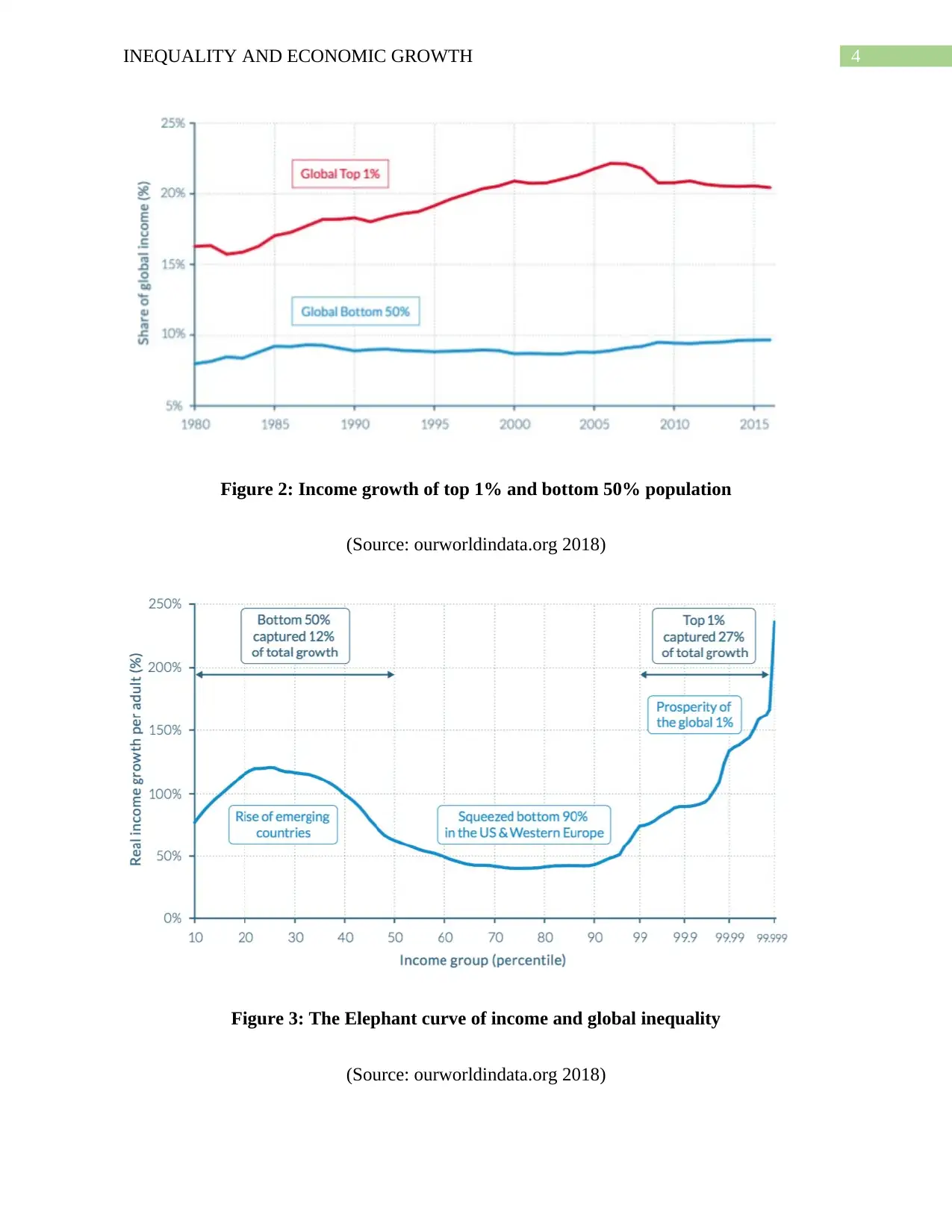
4INEQUALITY AND ECONOMIC GROWTH
Figure 2: Income growth of top 1% and bottom 50% population
(Source: ourworldindata.org 2018)
Figure 3: The Elephant curve of income and global inequality
(Source: ourworldindata.org 2018)
Figure 2: Income growth of top 1% and bottom 50% population
(Source: ourworldindata.org 2018)
Figure 3: The Elephant curve of income and global inequality
(Source: ourworldindata.org 2018)
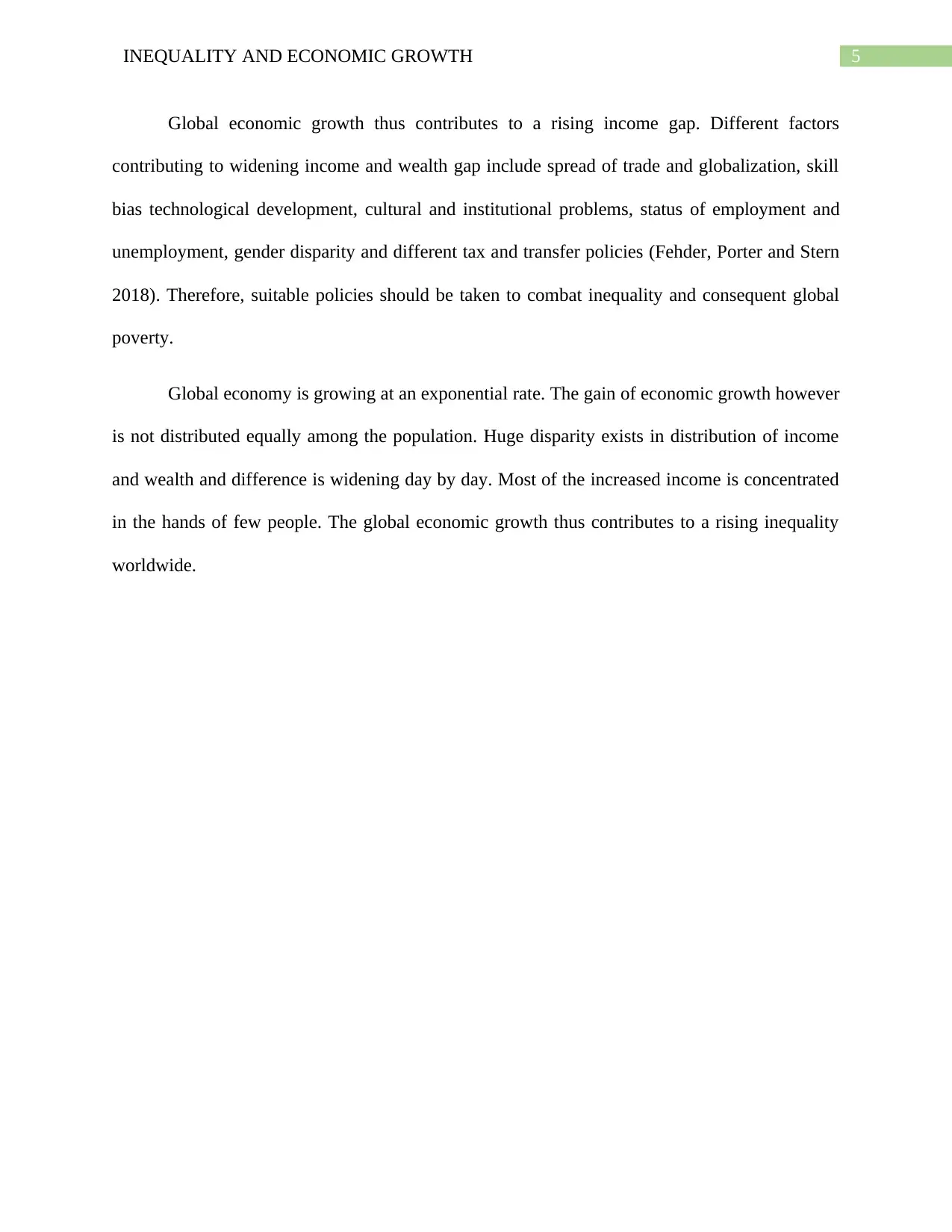
5INEQUALITY AND ECONOMIC GROWTH
Global economic growth thus contributes to a rising income gap. Different factors
contributing to widening income and wealth gap include spread of trade and globalization, skill
bias technological development, cultural and institutional problems, status of employment and
unemployment, gender disparity and different tax and transfer policies (Fehder, Porter and Stern
2018). Therefore, suitable policies should be taken to combat inequality and consequent global
poverty.
Global economy is growing at an exponential rate. The gain of economic growth however
is not distributed equally among the population. Huge disparity exists in distribution of income
and wealth and difference is widening day by day. Most of the increased income is concentrated
in the hands of few people. The global economic growth thus contributes to a rising inequality
worldwide.
Global economic growth thus contributes to a rising income gap. Different factors
contributing to widening income and wealth gap include spread of trade and globalization, skill
bias technological development, cultural and institutional problems, status of employment and
unemployment, gender disparity and different tax and transfer policies (Fehder, Porter and Stern
2018). Therefore, suitable policies should be taken to combat inequality and consequent global
poverty.
Global economy is growing at an exponential rate. The gain of economic growth however
is not distributed equally among the population. Huge disparity exists in distribution of income
and wealth and difference is widening day by day. Most of the increased income is concentrated
in the hands of few people. The global economic growth thus contributes to a rising inequality
worldwide.
⊘ This is a preview!⊘
Do you want full access?
Subscribe today to unlock all pages.

Trusted by 1+ million students worldwide
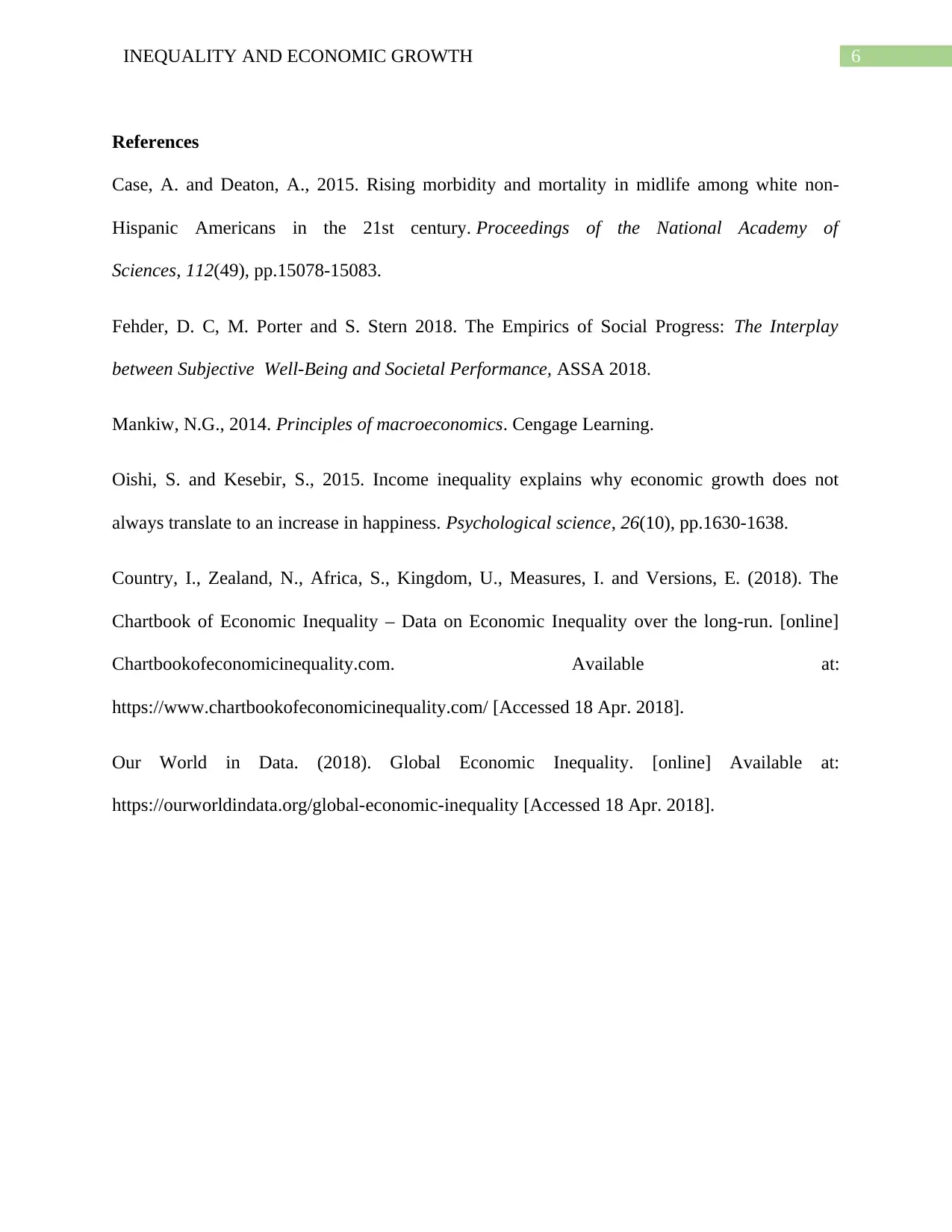
6INEQUALITY AND ECONOMIC GROWTH
References
Case, A. and Deaton, A., 2015. Rising morbidity and mortality in midlife among white non-
Hispanic Americans in the 21st century. Proceedings of the National Academy of
Sciences, 112(49), pp.15078-15083.
Fehder, D. C, M. Porter and S. Stern 2018. The Empirics of Social Progress: The Interplay
between Subjective Well-Being and Societal Performance, ASSA 2018.
Mankiw, N.G., 2014. Principles of macroeconomics. Cengage Learning.
Oishi, S. and Kesebir, S., 2015. Income inequality explains why economic growth does not
always translate to an increase in happiness. Psychological science, 26(10), pp.1630-1638.
Country, I., Zealand, N., Africa, S., Kingdom, U., Measures, I. and Versions, E. (2018). The
Chartbook of Economic Inequality – Data on Economic Inequality over the long-run. [online]
Chartbookofeconomicinequality.com. Available at:
https://www.chartbookofeconomicinequality.com/ [Accessed 18 Apr. 2018].
Our World in Data. (2018). Global Economic Inequality. [online] Available at:
https://ourworldindata.org/global-economic-inequality [Accessed 18 Apr. 2018].
References
Case, A. and Deaton, A., 2015. Rising morbidity and mortality in midlife among white non-
Hispanic Americans in the 21st century. Proceedings of the National Academy of
Sciences, 112(49), pp.15078-15083.
Fehder, D. C, M. Porter and S. Stern 2018. The Empirics of Social Progress: The Interplay
between Subjective Well-Being and Societal Performance, ASSA 2018.
Mankiw, N.G., 2014. Principles of macroeconomics. Cengage Learning.
Oishi, S. and Kesebir, S., 2015. Income inequality explains why economic growth does not
always translate to an increase in happiness. Psychological science, 26(10), pp.1630-1638.
Country, I., Zealand, N., Africa, S., Kingdom, U., Measures, I. and Versions, E. (2018). The
Chartbook of Economic Inequality – Data on Economic Inequality over the long-run. [online]
Chartbookofeconomicinequality.com. Available at:
https://www.chartbookofeconomicinequality.com/ [Accessed 18 Apr. 2018].
Our World in Data. (2018). Global Economic Inequality. [online] Available at:
https://ourworldindata.org/global-economic-inequality [Accessed 18 Apr. 2018].
1 out of 7
Related Documents
Your All-in-One AI-Powered Toolkit for Academic Success.
+13062052269
info@desklib.com
Available 24*7 on WhatsApp / Email
![[object Object]](/_next/static/media/star-bottom.7253800d.svg)
Unlock your academic potential
Copyright © 2020–2025 A2Z Services. All Rights Reserved. Developed and managed by ZUCOL.





